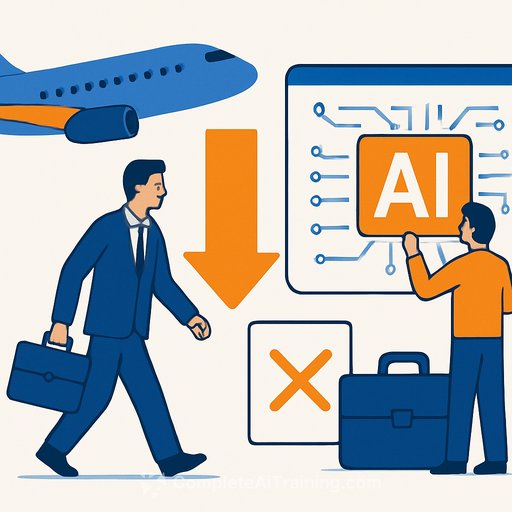United Airlines Cuts 4% of Management Roles Citing AI Efficiency
United Airlines said it reduced its management headcount by 4% as a direct result of adopting AI, with more cuts planned in 2026. This marks the first time a U.S. airline has publicly tied AI adoption to fewer management jobs.
"We're not just looking to make our operation more efficient. We're making changes and using AI to make the work of our headquarters management team more efficient too," said United CFO Michael Leskinen during an earnings call.
For managers, this is a clear signal: AI is reshaping white-collar work, not just frontline operations. The question is how to respond-proactively, not defensively.
Why This Matters for Management
- AI is compressing administrative work. Reporting, planning, and coordination can be automated or assisted-shrinking the need for layers of oversight.
- Span of control will widen. Fewer managers will oversee larger scopes as AI handles routine status, documentation, and analysis.
- Decision cycles will shorten. Faster insights mean fewer meetings, fewer approvals, and leaner structures.
Where AI Likely Cut Headcount
- Automated report generation and dashboarding for leadership updates
- Forecasting and scenario planning in finance and network planning
- Scheduling, resource allocation, and vendor management workflows
- Customer ops analytics and knowledge base content creation
- HR analytics, talent screening, and internal service ticket routing
What You Can Do Now
- Audit workflows. List recurring tasks, approvals, and reports. Tag anything repetitive, rules-based, or data-heavy for automation.
- Pilot AI "co-pilots." Start with one function-FP&A, procurement, or customer operations. Measure hours saved and error reduction.
- Redesign roles, not just tasks. Shift managers from status coordination to decision quality, risk controls, and coaching.
- Institute policy. Set clear rules for data access, human-in-the-loop reviews, and audit trails for AI-generated outputs.
- Upskill aggressively. Train teams on prompt strategy, tool stacks, and metrics literacy to keep productivity gains in-house.
Metrics to Track
- Cost per management FTE and span of control
- Cycle time for reports, forecasts, and approvals
- Forecast accuracy and variance reduction
- Quality KPIs: error rates, rework, compliance exceptions
- Adoption: % workflows with AI assistance and time saved
Risk, Controls, and Governance
- Set review checkpoints for any AI-generated analysis used in decisions.
- Protect sensitive data with access controls and vendor due diligence.
- Document prompts, outputs, and decisions for auditability.
- Provide change management support to prevent shadow tools and process drift.
Strategic Takeaway
AI will shrink middle-management overhead while raising the bar for judgment, systems thinking, and accountability. Managers who learn to convert efficiency gains into better decisions and stronger teams will keep their edge. Those who stay in coordination mode will get automated.
If you want a structured path to upskill your team, explore practical courses by job role at Complete AI Training.
For context on company communications and updates, see United's investor relations page: ir.united.com.
Your membership also unlocks:






